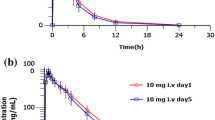Summary
In a randomised double-blind cross-over study, 8 normal subjects received propranolol 80 mg twice daily with omeprazole 20 mg or identical placebo each morning. Propranolol kinetics were measured on day 8 of both treatment periods.
Areas under the propranolol concentration/time curves were not significantly increased by omeprazole treatment: off treatment mean 787.6, on treatment 802.5 ng−1·ml·h. Maximum and minimum steady-state propranolol concentrations were similarily unaffected. Omeprazole also failed to increase the clinical effect of propranolol, as assessed by exercise tests on Day 8 of treatment.
We conclude that omeprazole in the dose likely to be used for peptic ulcer has no significant effect on the kinetics or action of propranolol.
Similar content being viewed by others
References
Henry DA, Somerville KW, Kitchingman G, Langman MJS (1984) Omeprazole: Effects on oxidative drug metabolism. Br J Clin Pharmacol 18: 195–200
Gugler R, Jensen JC (1985) Omeprazole inhibits oxidative drug metabolism. Gastroenterology 89: 1235–1241
Jensen JC, Gugler R (1986) Inhibition of liver cytochrome P-450 by omeprazole. Br J Clin Pharmacol 21: 328–330
Bruce RA (1971) Exercise testing of patients with coronary heart disease. Ann Clin Res 3: 323–332
Smith MT, Livingstone I, Hooper WD, Eadie MJ, Triggs EJ (1983) Propranolol, propranolol glucuronide and naphoxylactic acid in breast milk and plasma. Ther Drug Monit 5: 87–93
Mihaly GW, Prichard PJ, Smallwood RA, Yeomans ND, Louis WJ (1983) Simaltaneous high performance liquid chromatographic analysis of omeprazole and its sulphone and sulphide metabolites in human plasma and urine. J Chromatogr 278: 311–319
Reimann IW, Klotz U, Siems B, Frolich JC (1981) Cimetidine increases steady state plasma levels of propranolol. Br J Clin Pharmacol 12: 785–790
Feely J, Wilkinson GR, Wood AJJ (1981) Reduction of liver blood flow and propranolol metabolism by cimetidine. N Eng J Med 304: 692–695
Cooperative Study (1984) Omeprazole in duodenal ulceration: Acid inhibition, symptom relief, endoscopic healing, and recurrence. Br Med J 289: 525–528
Howden CW, Kenyon CJ, Beastall GH, Reid JL (1986) Inhibition by omeprazole of adrenocortical response to ACTH: Clinical studies and experiments on bovine adrenal cortex in vitro. Clin Sci 70: 99–102
Lloyd-Davies KA, Rutgersson K, Solvell L (1986) Omeprazole in Zollinger-Ellison Syndrome: Four year international study. Gastroenterology 90: 1523
Henry DA, Gerkens JF, Brent PJ, Dosen PJ (1986) Omeprazole: Effects on oxidative drug metabolism in the rat. Clin Exp Pharmacol Physiol 13: 377–381
Webster LK, Jones DB, Mihaly GW, Smallwood RA (1984) Effects of omeprazole and polyethylene glycol-400 on antipyrine elimination by the isolated perfused rat liver. J Pharm Pharmacol 36: 470–472
Author information
Authors and Affiliations
Rights and permissions
About this article
Cite this article
Henry, D., Brent, P., Whyte, I. et al. Propranolol steady-state pharmacokinetics are unaltered by omeprazole. Eur J Clin Pharmacol 33, 369–373 (1987). https://doi.org/10.1007/BF00637632
Received:
Accepted:
Issue Date:
DOI: https://doi.org/10.1007/BF00637632




